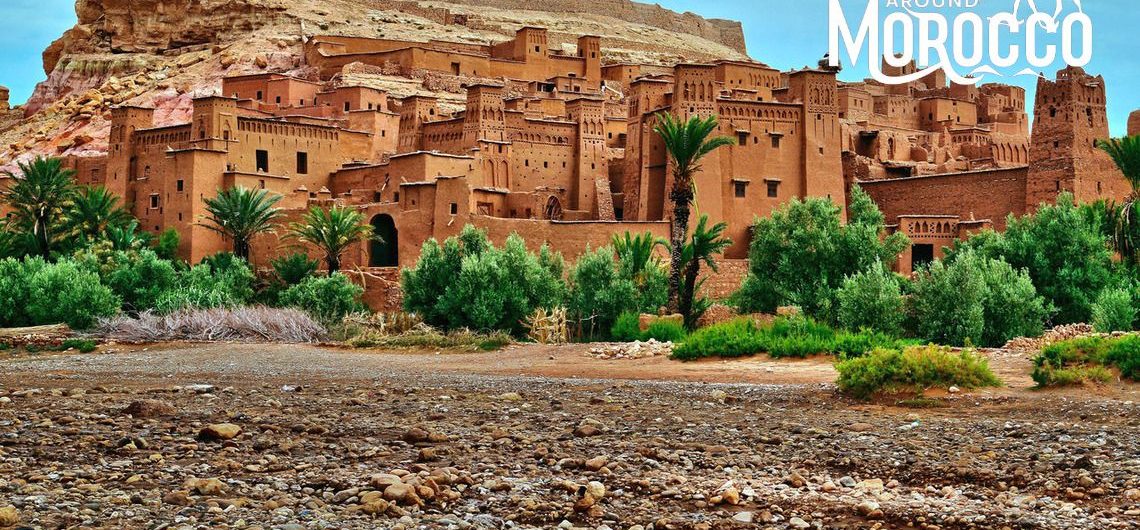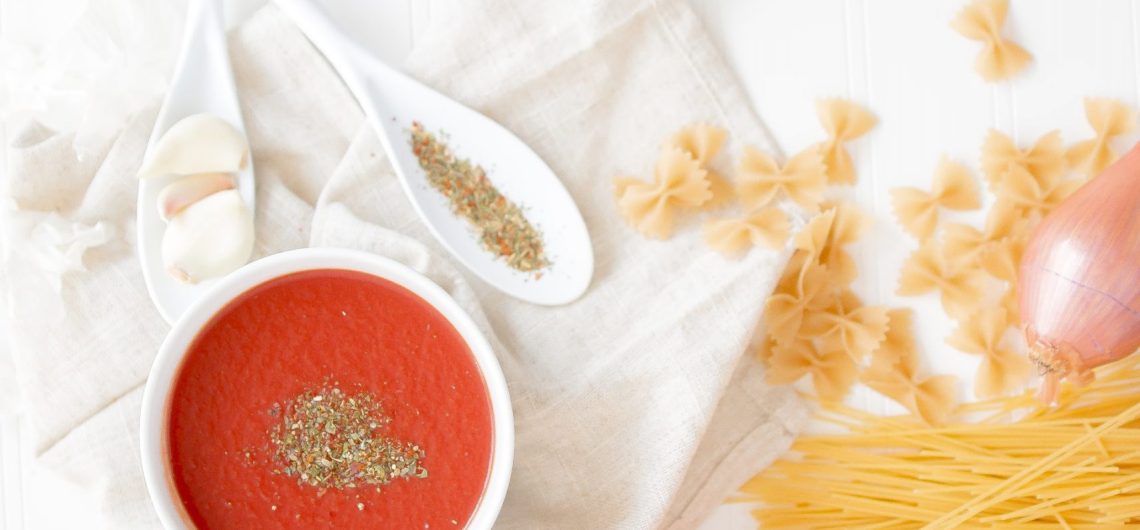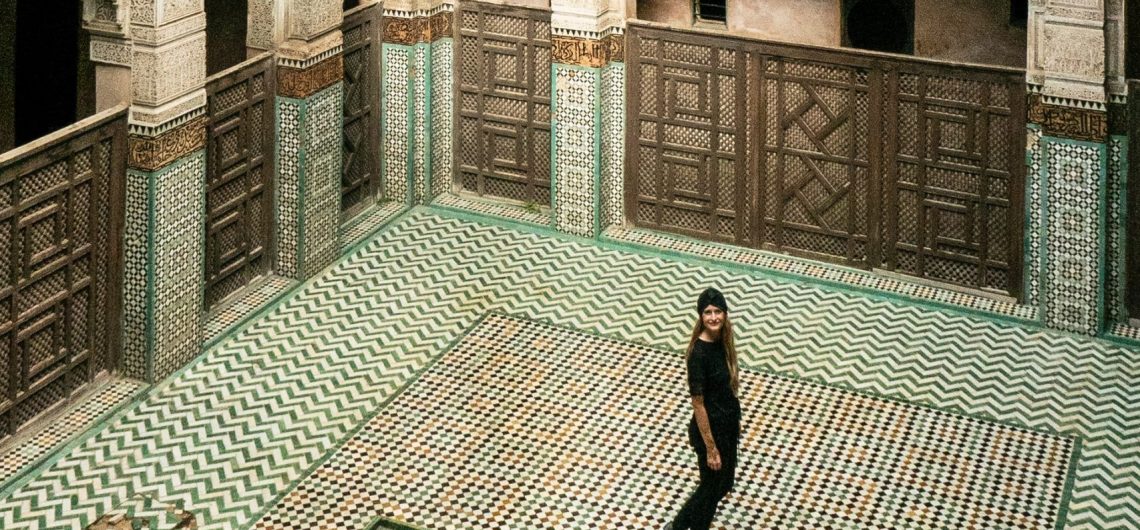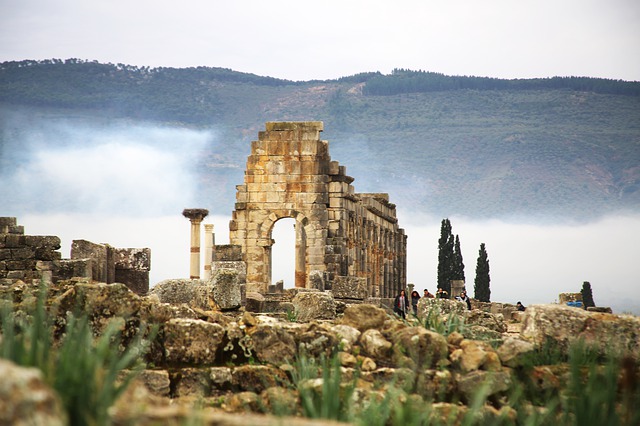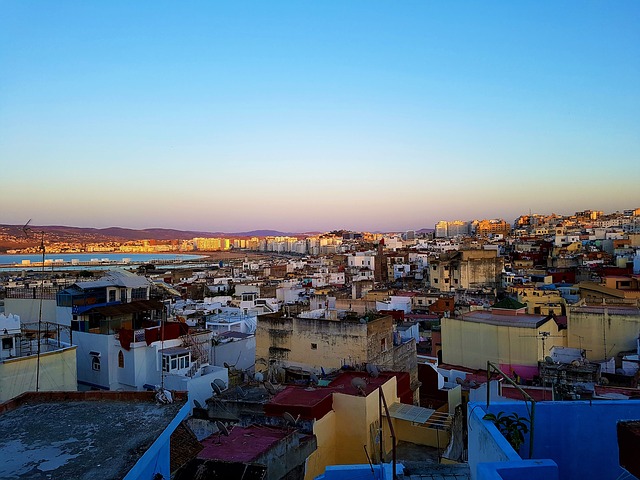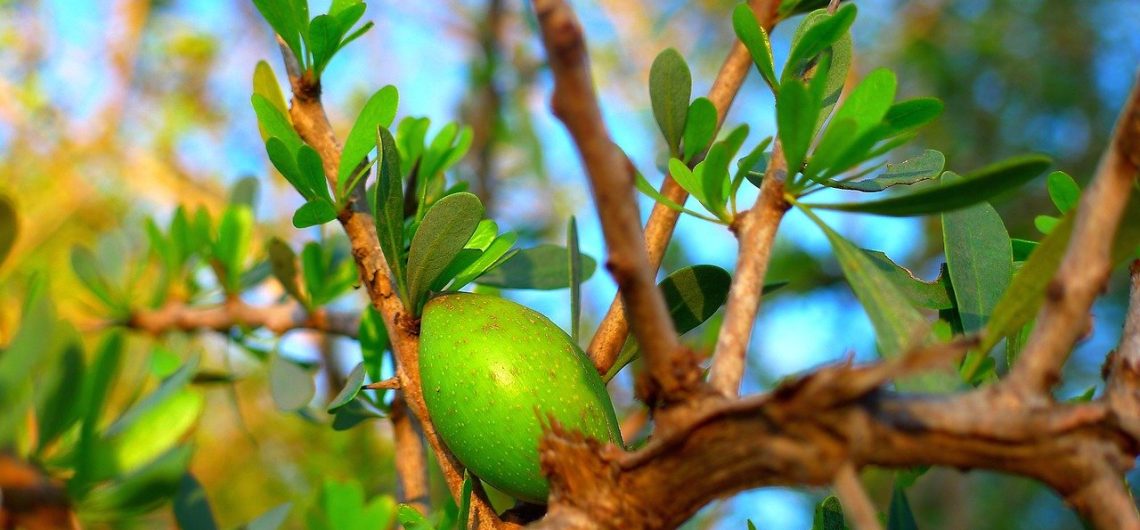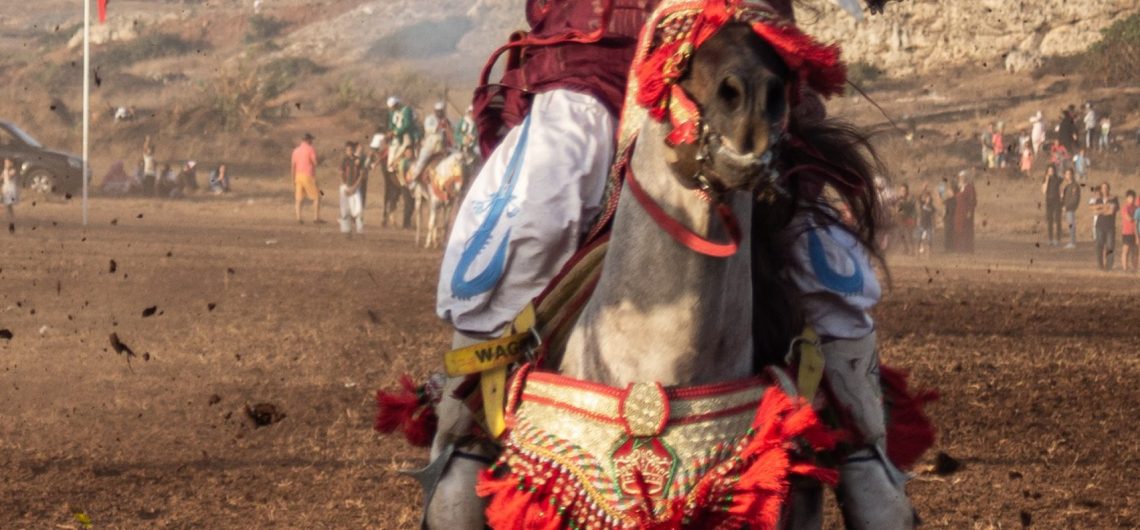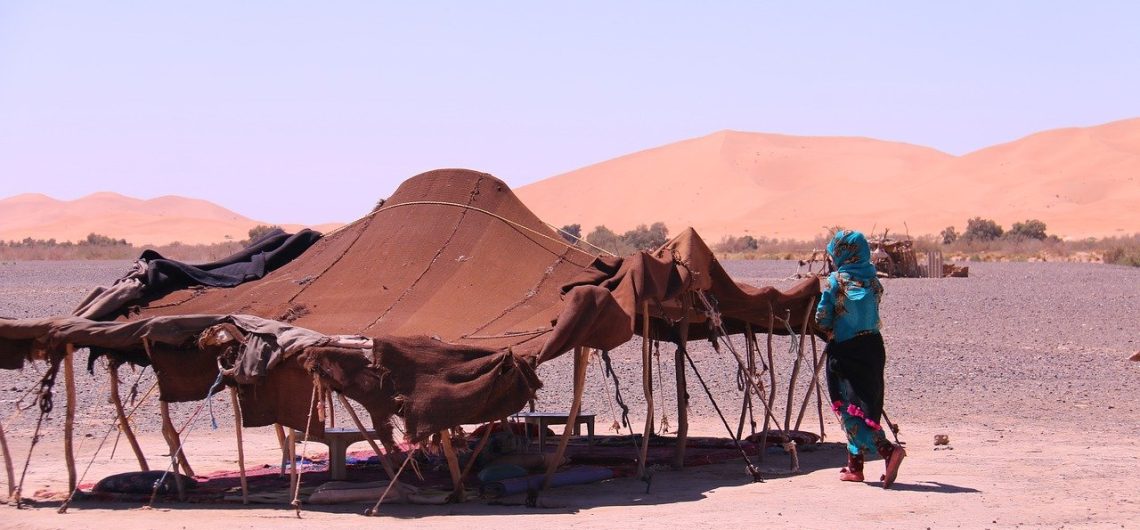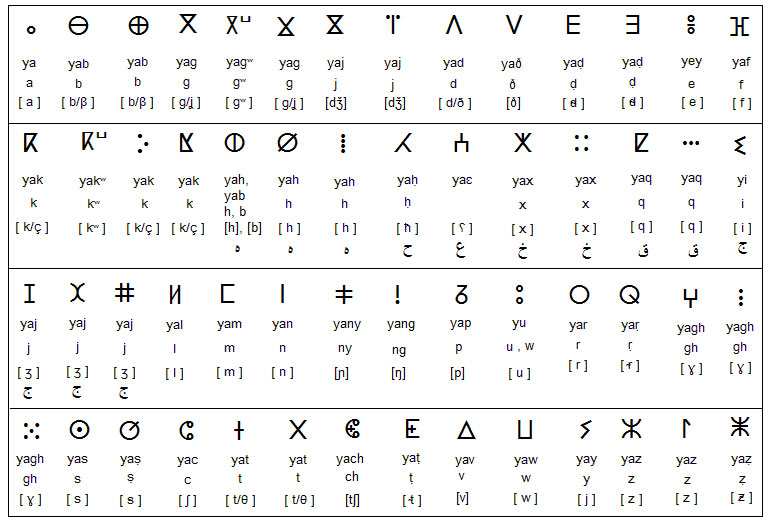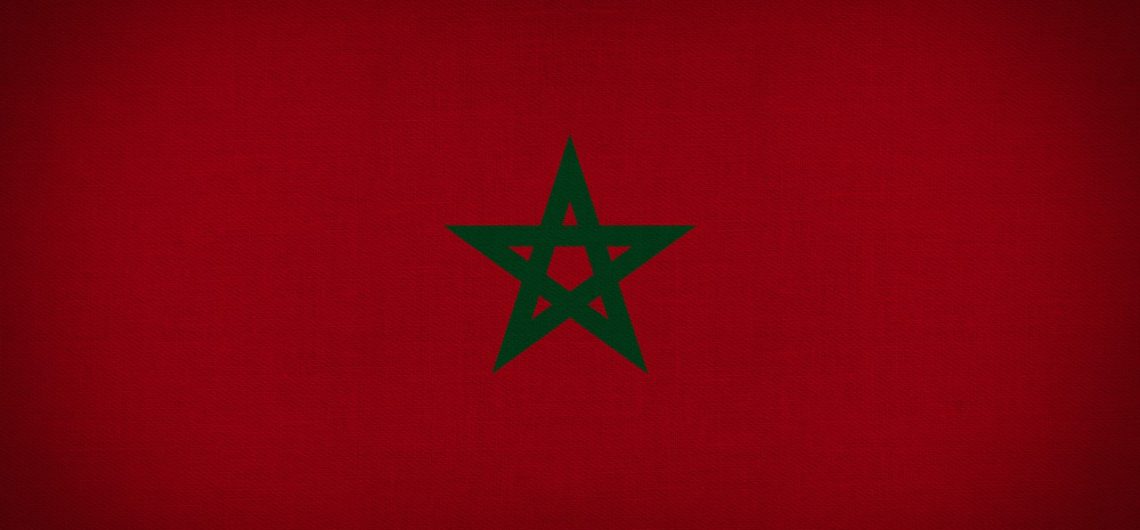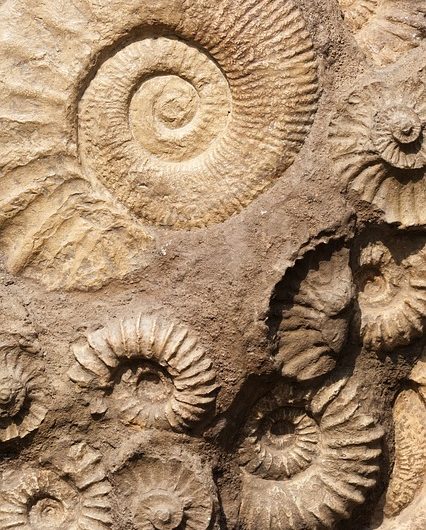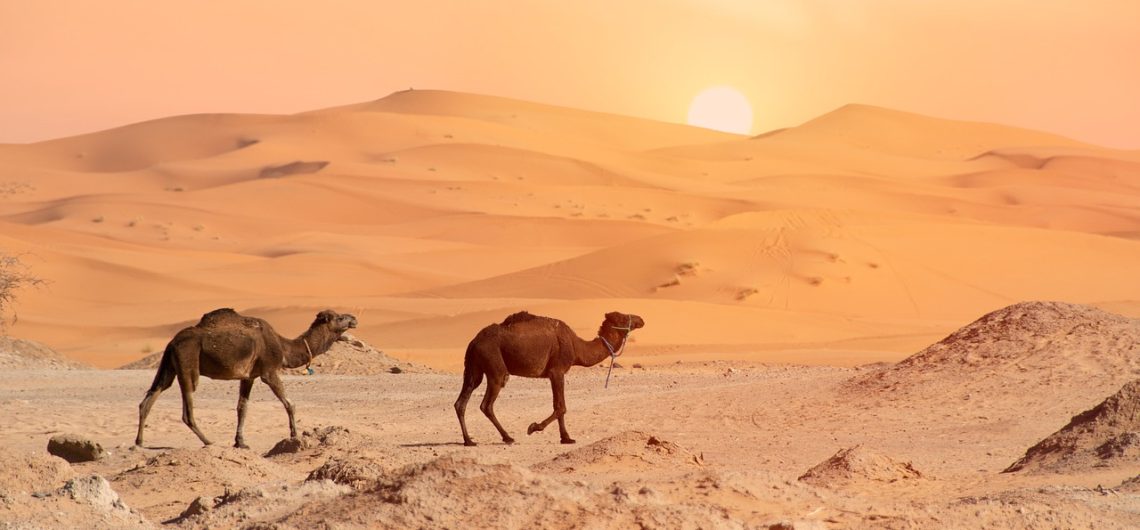Moroccan land This is how the inhabitants of today's Morocco usually answer the question about their nationality. The term "Moroccan nation" is widely used in political speeches and newspaper articles. However, when Moroccans call themselves a nation, they are referring primarily to the commonality of historical destinies and belonging to the same state. As for the process of strengthening the commonality of language, economy, and culture, it is far from complete. The notion of "Moroccan land" has come into use mainly among the inhabitants of industrial centers, where capitalism settled relatively long ago and, therefore, managed to remelt in its crucible elements of different tribes and diverse in their cultural traditions, customs, mental structure, and language into a relatively uniform mass, subject to the laws of bourgeois production relations, that is the basis on which the nation emerges. In a village, when asked "who are you?" you might be told, "We are the Iliad Hammu," that is, "children," descendants of a certain Hammu who founded the village. Some old man will tell you that Hammu belongs to the "children" of Abdenbi, who inhabit several surrounding villages, and that the "children" of Abdenbi themselves are part of a larger group that constitutes a "Kabila," or tribe. Instead of the word "ulyad" one may find Arabic "beni" and Berber "ait" having the same meaning, which in combination with a specific name denote a particular tribe or group of related tribes. geographical area Often a geographical area or locality is named after a tribe. For example, in northeastern Morocco there are the Beni-Snassen Mountains, one of the provincial centers is called Beni-Mellal, and there are small towns and villages with names such as Ait Ammar, Ait-Urir, Ait-Souala, etc. scattered throughout the country. It should be stipulated that large tribal formations do not necessarily
Moroccan land
This is how the inhabitants of today’s Morocco usually answer the question about their nationality. The term “Moroccan nation” is widely used in political speeches and newspaper articles. However, when Moroccans call themselves a nation, they are referring primarily to the commonality of historical destinies and belonging to the same state. As for the process of strengthening the commonality of language, economy, and culture, it is far from complete. The notion of “Moroccan land” has come into use mainly among the inhabitants of industrial centers, where capitalism settled relatively long ago and, therefore, managed to remelt in its crucible elements of different tribes and diverse in their cultural traditions, customs, mental structure, and language into a relatively uniform mass, subject to the laws of bourgeois production relations, that is the basis on which the nation emerges.
In a village, when asked “who are you?” you might be told, “We are the Iliad Hammu,” that is, “children,” descendants of a certain Hammu who founded the village. Some old man will tell you that Hammu belongs to the “children” of Abdenbi, who inhabit several surrounding villages, and that the “children” of Abdenbi themselves are part of a larger group that constitutes a “Kabila,” or tribe. Instead of the word “ulyad” one may find Arabic “beni” and Berber “ait” having the same meaning, which in combination with a specific name denote a particular tribe or group of related tribes.
geographical area
Often a geographical area or locality is named after a tribe. For example, in northeastern Morocco there are the Beni-Snassen Mountains, one of the provincial centers is called Beni-Mellal, and there are small towns and villages with names such as Ait Ammar, Ait-Urir, Ait-Souala, etc. scattered throughout the country. It should be stipulated that large tribal formations do not necessarily bear the name of an “ancestor,” but maybe called, for example, ait-umalu, or “sons of the shadow. The inter-tribal confederations and the geographical names born by them do without prefixes “ulyad”, “beni”, “ait”.
Of course, all these tribal names nowadays are not uncommon as a tribute to the past and do not always reflect the real reality. The tribal ties have become entangled over centuries of spontaneous migrations, relocations by sultan decrees, and the transformation of many rural inhabitants into urban dwellers. The rural areas of the Moroccan plains are generally characterized by a tendency toward the disappearance of the primitive communal system. The development of commercial exchange and the assertion of private ownership of Moroccan land and livestock led to the stratification of the village. At one pole there was a wealthy upper class of large landowners among the tribal nobility who appropriated communal property.
Moroccan peasants
At the other pole were the landless and land-poor poor and the semi-poor shepherds. The relations between the people became class-based. This process was to some extent facilitated by the contradictory policies of the colonial administration during the protectorate period. The colonizers attempted to establish territorial boundaries of tribal settlement and even conserve what remained of the communal property. It was certainly not a question of protecting the interests of Moroccan land peasants.
The abolition of non-recognition of Moroccan private property was necessary in order to clear the way for French colonists to seize the land. And when the influx of colonists ended, the “rights” of the Moroccan clan nobility and wealthy landowners could be recognized. The colonial administration not only took it upon itself to defend this stratum against the rebellious communists but openly encouraged the sheiks, ways, and pashas to seize the communal Moroccan land, not stopping at sending punitive expeditions into the countryside to “pacify” the freedom-loving Moroccans who would not submit to the “civilizers.
Moroccan land tribal
The forcible “ordering” of tribal life, the introduction of “European,” that is, capitalist, methods of Moroccan land management, the growth of industrial cities, which absorbed in their bottomless stone wells a large mass of the rural population, of course, were a great shock to tribal structures and accelerated the decay of the tribal system. But not to the end. All the more so because, next to the capitalist farms of the colonists, the Moroccan land peasants, whose way of life was hardly touched by the innovations of the colonizers, continued to cultivate the land in the ancestral ways.
And the latter did not seek to eliminate tribal remnants. On the contrary, they were more than happy to see the backward ways of development hinder the consolidation of the Moroccan nation and the growth of a national consciousness: it is much easier to deal with a people that had not completely overcome the stage of tribal fragmentation. The tribal traditions are still alive today, even though the Moroccan government is taking steps to organize national life and foster a sense of national identity among all Moroccans.
In principle, the present “tribe,” apart from the group of families that form its nucleus and give it its name, includes many people whose ancestral roots have nothing to do with the genealogical tree of the tribe. But despite the heterogeneity of the tribe’s composition and social differentiation, it continues to be often a rather cohesive group of people following common traditions. The Moroccan village (duar) lives today as one large family, although it often has hundreds of inhabitants. Everyone there knows everything about each other: there are no secrets from the “brothers” and “sisters”. And everyone is known by name. People with the same name are distinguished by mentioning their father’s name: M’hammed ben-Ahmed, M’hammed ben-Abdallah, etc. Or the mother, if the father is a stranger: M’hammad-uld-Aisha, The need for a surname appears when a person leaves his native village.
In the neighboring duar, Mhammed, the son of Ahmed or Aisha of the duar of Ulead Hassan, would become M’hammed el-Hassouni, for the people there do not know the name of his father or mother. In the further movement of this person, the tribal “surname” may be superseded by the tribal surname, and when he leaves his native lands and moves to Casablanca or Rabat, he will either keep his tribal “surname” or make his final surname the name of the confederation of which his tribe is a part. The above-mentioned M’hamed may be given an identity card with a Sergini surname that reminds him of his belonging to the Sragna tribal association. Such surnames are very common among urban dwellers, along with “patronymics” like Benham or Benaissa and even city names like Fassi for natives of Fez…
In the semi-desert zone and in the mountains, where the rural life remains firmly connected to the nomadic cattle-breeding, which is inconceivable outside the framework of communal customs, the tribal structure has not undergone such degradation as in the agricultural areas. Although the institution of private property (on livestock) is also established here and people have become familiar with such social inequality, the way of life contributes to the preservation of many traditions of the past. The main philosophical principle of the nomad is that one cannot live alone in the vast world of the desert. Generosity is an inherent property of a nomad, brought up in the spirit of respect for an unspoken law of nomadic society – solidarity, for without it there is no social life, and without social life in the desert, there can be no individual life. A lonely man is a dead man. He cannot lead his flock alone, give it water, ensure its safety. This ethic of the desert man is a matter of life and death for the whole family, clan, tribe…
The Berber
The Berbers, Arabized Berbers, and Arabs constitute the bulk of the population of Morocco. French sources, noting the wide dissemination of Arabic in the country, at the same time claim that the majority of Moroccans are Berbers. The same view is held by the Berbers themselves. The fact that many of them know Arabic does not mean that they have completely forgotten their mother tongue. A famous political figure of Morocco, the leader of the Berber party “People’s Movement”, poet and artist Mahjoubi Akhardan, while putting forward a demand to teach the Berber language, argues that this demand does not at all aim to oppose the Berber to the Arab, for in the Moroccan reality they have long lived together and are inseparable brothers.
Moroccan Berbers have lost their own alphabet, the existence of which is evidenced by both the findings of archaeologists (although written monuments attributed to the distant ancestors of the current Berbers cannot yet be deciphered), and the ancient writing system “Tifinagh”, preserved by the Tuareg related Berbers in some areas of Algeria and Niger.
Berber language
But the oldest Berber language in North Africa, says Ahardan, continues to live in the daily communication of its owners, in their oral literature – Berber tales, legends, proverbs and sayings, poems and songs, as well as in written documents that use the Arabic alphabet. It is an accurate and lively language and its protection is necessary to preserve the rich cultural heritage of the Berber people. By the way, the Berber-speaking Moroccans are not a handful of people, but 50-60% of the population!
Indeed, a few kilometers away from the Atlantic coast, along which the Arabs mostly settled, or from the major cities surrounded by Arab settlements, you find yourself in Berberian. Here women walk around with open faces and dress in colorful clothes. And red-haired and blue-eyed children are not uncommon. And the accommodation is very often a huge black tent that can accommodate fifty, a hundred or more people under a tent. Berber carpets with their unique pattern can hardly be confused with the products of Arab masters from Rabat and Fez. Berber folk dances have their own characteristics.
Berbers themselves
Berbers themselves call themselves so only when they speak French or English. The Berbers of the Rif, for example, prefer another name-“Imazighen” (“free people”). The central part of the country, the mountains of the Middle Atlas, the eastern slopes of the High Atlas, and the valleys of the Puedes, lost in the sands of the Sahara, are inhabited by the Sanhaja tribes, the Berbers. They, too, consider themselves Amazigh, and, like the Imazighs of the Rif, call their language “Tamazight,” though there are significant differences between them.
The inhabitants of the High Atlas, the Anti-Atlas, and the Sus River Valley are called Schlecht. They are the descendants of the Mahmud, who appeared in Morocco before all other Berbers. The language of the Schlecht is Tashelhit. Each of these main groups is characterized by a variety of local accents, but all the inhabitants of the Rif understand each other in the same way that the Schlecht and the Brabbers can communicate with each other, but between the Schlecht and the Imazighs of the Rif lies a serious language barrier. Such a barrier also exists between the Arabs and those the Berbers who do not know Arabic. And the Arabic language itself in Morocco is dialectal, and its dialects vary from one area to another.
The Arabic language
Classical or Literary Arabic – the language of the Koran, jurisprudence, science, fine literature, business correspondence, and the press – is known to only a handful of literate people and is not yet a means of communication for the vast majority of the population, who can neither read nor write. So far, the so-called vernacular language, which has many Berber words and expressions and French terms, remains a means of communication. It is fair to say that in some areas, including rural areas, the Arabization of Berbers and the mixing of tribes have reached such a degree that sometimes it is difficult to distinguish the Arabized Berber from a Berber who has acquired or even a “purebred” Arab.
In addition, mixed marriages between Arabs and Berbers are very common in Morocco. But it is quite possible that some Berber groups, especially the Highlanders, will keep their identity and form nationalities, which will develop in parallel with the further evolution of the forming Arabized Moroccan nation, which absorbed the descendants of the Spanish Muslims – Moriscos and Andalusians, the slaves from Western Sudan who had served in the Moroccan sultans’ “blackguards”; Today, the dark-skinned Moroccans of Tropical Africa do not form a distinct ethnic group, scattered throughout the cities and villages, sharing life with the Berbers and Arabs around them and speaking their dialects.
Jewish citizens
The Jewish citizens of Morocco have roots in this country that go as far back in time as most Berbers. As early as the third century BC, the first settlements of Carthaginian Jews appeared here, whose colonies were replenished over the next three centuries. The first immigrants completely assimilated with the Berber Gentiles, subjecting them to Judaization, and some current “Jewish” families have Berber ancestors. In the far south of Morocco, one can still find densely populated Jewish villages – mullahs – which are a living example of the symbiosis of Jewish communities with the surrounding Berber environment: they have the same customs, the same language, the same farming techniques, and even some common “saints.
The second wave of Jewish immigration is related to the persecution to which the Jews were subjected in medieval Europe. In the fourteenth and fifteenth centuries, thousands left Italy, Holland, France, England, and Portugal to find refuge in the Arab Maghreb. The most significant was the influx of Jews into Morocco from Spain: the Reconquista struck them as it did their Muslim compatriots, and their only route was from Andalusia, in the hands of the Catholic kings, to Tangier, Fey, and later to New Salé (Rabat). These new Jewish settlers originally spoke Spanish. For their descendants, Arabic became the mother tongue. Unlike in Europe, where anti-Semitism was fomented by those in power, in Morocco Jews were “guests” under the patronage of the sultans.
By the end of the nineteenth century, much Moroccan land had been assimilated. In their way of life, the Jewish poor were now no different from the Arab or Berber poor, and the Jewish bourgeoisie found common ground with their Muslim classmates very well. Antisemitism is still uncommon to the broad masses of Moroccans these days. Nor are the Moroccan authorities prone to it. Even during the difficult period of Vichy’s rule in Morocco, Mohammed V flatly refused to apply in his country the so-called Nuremberg anti-Jewish laws which Putin’s protege, Resident General Notes, tried to impose on him.
Conquest of Morocco
As early as the preparations for the conquest of Morocco, the colonizers, through a system of “patronage,” drew to their side the bourgeois upper classes of the Jewish community, who, like some Arab bourgeois families, preferred national solidarity to class solidarity – with foreign companies. With the establishment of the French protectorate, the Jewish bourgeoisie became a direct accomplice of the colonial authorities.
And the schools and cultural centers of the Rothschild-funded World Alliance of Israelites successfully indoctrinated Jewish children into thinking of Moroccan land. People who for years were indoctrinated that they were not Moroccan, and then declared that their true Moroccan land was Palestine, became rather easy prey for Zionist propaganda. In 194.5 there were 250,000 Jews in Morocco, by 1970 their numbers had dropped to 40,000. It was mainly the poor who emigrated to Israel. The result was the famous deproletarianization of the Jewish community in Morocco.
Frenchmen in Morocco
There are many Frenchmen in Morocco whose fathers, grandfathers, or even great-grandfathers settled here during the Protectorate or even much earlier. They are often called the Moroccan land French. They were quite firmly established in the business districts of Moroccan cities and rural estates, in educational institutions and government offices, but the vast majority did not become citizens of independent Morocco, preferring to maintain their links with France.
Moroccan land soil
With the abolition of the colonial regime on Moroccan land soil, where the French felt like masters for nearly half a century, they found themselves in the position of foreigners. Their fate depends on the steadily expanding Moroccanization of the economy and of all social life in that country. Many French locals live in anxious anticipation of the moment when they may have to pack their bags and leave the comfort of their own homes. On the eve of the independence of Morocco, the number of the French there reached 400-450 thousand and in 1970 there were already 90 thousand, although the situation of the French colony in recent years has stabilized somewhat, the downward trend seems to have become irreversible. This is equally true of the Spanish colony (45,000 people) and of many other foreign settlers.
Foreigners in Morocco are now only 170,000. They constitute a little more than 1% of its population, whose total number exceeds 15 and a half million.
Moroccan land orthodox
With the exception of the Jewish minority, in which Orthodox Judaism is prevalent, and the few Moroccans who are Christians and atheists, the indigenous population is practiced by all, or nearly all, Muslims, who are obliged to follow the Koran, the holy book of Islam, and the Sunna as expressed in the Hadith, which means to follow the example of the Prophet and his companions in their behavior.
In the Koran and the Sunna, the orthodox Moroccan seeks answers for all occasions, while the Sharia, which still serves as the legal basis for some judicial decisions, is applied in Morocco according to the methodology of the eighth-century Muslim jurist Malek ibn Anas. Therefore, Moroccans are considered to be Malekite Sunnis.
However, it seems that we cannot limit ourselves to this general definition. First of all, if only because Moroccan “orthodoxy” does not prevent the existence in the country of numerous religious fraternities founded by “holy” sheriffs and marabouts, each of whom considered it his duty to “deepen” orthodox Islam with all kinds of mystical doctrines, rites and rules, and in fact contributed to the widespread of sectarianism, still alive today. In addition, pre-Islamic beliefs have by no means completely disappeared…
About two hundred kilometers south of Casablanca, at Cape Beddusa, where the lighthouse now stands, there was once a temple of Poseidon. The God of the sea was also considered the tamer of horses. Even nowadays, at the full moon, some Berber tribes, long practicing Islam, drive barren mares into the ocean waves in the hope of the mysterious stallions that live in the abyss, in the domains of Poseidon. The prayers of the men sitting on the coastal sand in long wait turn to him. It’s night, the moon glints on the crests of waves, the glistening torsos of mares in the snow-white sea foam. A spectacle is truly improbable for a country of Islam. However.
Moroccan Muslims
Among Moroccan land Muslims, especially Berbers, there are still many people who really pay tribute to the remnants of pantheism, believe in good and evil spirits, in witches and sorcerers, fear the “evil eye”, rely on various magical remedies for illnesses and other troubles … The well-known fatalism is not alien to them. But it is not only in this but also in the great difference in the understanding of Islam and in the attitude to its precepts, which can be observed between an educated person and a simple illiterate Fellah.
The Moslem religion still plays an essential part in the daily life of many Moroccan land, especially peasants, who sincerely believe that “there is no god but Allah” and honor the Prophet Mohammed and all kinds of “saints”, who respond to the call of the muezzin and, if nothing prevents, spread their prayer mats at the proper hour to praise Allah, precede every undertaking with the cry “bismillah! “, calling upon the help of Allah, and if they promise anything or make any wish, they are sure to stipulate: “Inshaallah!” (“If Allah wills!”). All important events in the life of a Moroccan believer, be it circumcision, marriage, or death, are celebrated with appropriate rites. On Fridays, he considers it his duty to pray in the mosque. On major festivals, the mosques are full of people gathering, preaching, holding night vigils and theological conferences, sometimes inviting erudite theologians from other Muslim countries, as was the case, for example, in late 1968 and early 1969, when Morocco organized the celebration of the 1,400th anniversary of the Koran. The most important ceremonies are presided over by the king as “lord of the faithful” and by the most important imam.
Islam is the state religion. It is also written in the constitution. In order to maintain the religious spirit of the people, the state builds more and more mosques. It organizes Koranic schools for children 5-7 years old. It maintains at its own expense one of the oldest Muslim institutions, the University of Qaraoui, which has about a thousand students in theological faculties in Fez, Marrakesh, Tetouan, and Rabat and establishes new colleges of theology. The state assists men and women who wish to make the pilgrimage to Mecca. For this purpose, entire steamships are rented and special agreements are made with foreign airlines.
Religious affairs in Morocco are handled by a special government agency, the Ministry of Habous and Islamic Affairs. The habus are the property of the Muslim community and, so to speak, the material basis of its activity. The Ministry is in charge of mosques, Koranic schools, valuable collections of books and old manuscripts, maintains over 20 thousand worshipers (imams, muezzins, etc.), supports charity organizations, operates hospitals and orphanages, manages a large area of agricultural land, hires laborers and craftsmen to build new and restore old mosques, publishes its own magazine.
The law, including the penal code, protects the interests of religion, establishing various penalties for religious misconduct, in particular for failure to observe the rules of the Muslim fast, Ramadan, in public places.
Ramadan in Moroccan land
Ramadan in Moroccan land is a serious matter. For a whole month, a Muslim may not eat, drink or smoke from sunrise to sunset. In the wintertime, this is all right. Some Muslims simply sleep during the day, with the windows closed, to conserve their strength for the night-time vigil, when everything is permitted. Of course, only a few manage to do this, as businesses and institutions do not close during Ramadan, and fieldwork cannot be canceled. One consolation is that the days are not very long, and the heat is not oppressive.
But the Muslim year, composed of lunar months, is shorter than usual, and Ramadan can occur in summer. For the working man, fasting then becomes a real ordeal: the day drags on long, the mouth is dry and one feels dizzy, and what kind of work is it if all the time there is a bowl of steaming, spicy meat soup, the harira, in front of the eyes, which can be touched not before the cannon strikes to announce that the sun has finally retreated below the horizon and the fast is broken until morning. People look forward to this moment so much that with the cannon shot the streets are instantly empty. Having grown hungry during the day, one takes to eating several times during the night, forgetting about sleep. And in the morning, everything starts all over again…
It is not difficult to understand the great joy with which Moroccans greet the “small feast” (Haid el-Seger) that marks the end of Ramadan. It is usually a family celebration.
The “purification” of the fast seems to pave the way for the mass pilgrimage to Mecca. This period includes the “great feast” (Aid el-Kebir), which comes 70 days after the “small feast.
people simply
The people simply call it the Feast of the ram, because it begins when the king in the presence of a crowd of believers cuts the throat of a sacrificial lamb as if reproducing the gesture of the biblical patriarch Abraham (Ibrahim), acceptable to Allah, who, along with the forefather Adam, Moses (Musa), Jesus Christ (Aissa), and other Old and New Testament characters, is considered by Islam to be the predecessor of Muhammad, the chief and last of the prophets.
After a solemn prayer, all those who have stocked up on live lambs in advance, slaughter them in their homes and begin to feast. True, not everyone has money for this, and the poor settle for almsgiving in the form of tripe: giving alms, especially on holidays, is a sacred duty of every Muslim.
The Moroccans also celebrate many other Muslim holidays, but especially popular are the mousses at the “holy” graves, to which many thousands of pilgrims converge every year, each at a different time of the year, because the dates of the mousses are fixed according to the common, and not the Muslim, calendar. The museum begins with religious ceremonies and develops into a popular festivity, beginning to resemble a huge fair.
One of the main attractions of the fair is the famous “fantasia,” which gathers thousands of spectators. “Fantasia is not a horse race in the usual sense of the term, although it involves only riders. A spacious area, sometimes larger than a soccer field, is set aside for the performance. A group of riders lined up at one edge of the platform is armed with ancient flintlocks or quite modern Berber carbines. Their task is to start galloping their horses, dashing to the tribune with the guests of honor at the opposite end of the platform, stopping suddenly at full gallop a few meters from it and firing all their guns into the air.
The more coherent the riders, the more cohesive the volley, the greater the approval they will receive from their fellow tribesmen, who have entrusted them to uphold the honor of their tribe or village in this peculiar contest. One group alternates with another; the loser who has fallen off his horse sits down again to wash away his shame; the experienced rider returns again and again to show his skill; clouds of gunpowder smoke and clouds of dust rise over the rallying ground…
The occasions for local celebrations can be a provincial fair and the return of pilgrims from Mecca, the birth of a child by a wealthy Muslim, and the holding of several weddings at the same time.
Holiday of Moroccan land
The national holiday of Morocco is March 3. On this day King Hassan II ascended the throne in 1961. May 1 is officially celebrated as Labor Day. In mid-May – the holiday of the armed forces with the obligatory military parade. July 9 – the king’s birthday – is considered a holiday for youth. August 20 – the anniversary of the “Revolution of the King and the People”: in 1953 the late Mohammed V went into exile, which triggered a frenzy of national resistance to the colonizers, which was crowned with success. The return of Mohammed V to Morocco in 1955 is celebrated annually on November 16-18 as a celebration of the “three glorious days” symbolizing the country’s independence.
The Moroccans love their holidays and love to receive guests. According to an ancient custom, dates, and milk are presented to a special guest of honor. This staple food of the Saharan nomads became Moroccan land bread and salt.
In wealthy homes, the feast begins with the ritual of washing hands. Invitees are seated on carpets, sofas, and poufs around low tables, and an attendant approaches each of them in turn with a brass kettle, a special vessel for draining water, and a towel. Then everyone rolls up their right sleeve and begins to eat.
Moroccan land dishes
You have to eat with your hands, of course… But you don’t have to squirm squeamishly. Even in Europe, it is common to take the game with your hands. It is more convenient. After all, the way of eating is connected with the character of the dish. Chinese and Vietnamese dishes are much nicer to eat with chopsticks. Moroccan land dishes require neither forks nor chopsticks. Most of them are simpler, more convenient, “tastier” and therefore better eaten with the hands, as the Moroccans themselves and the foreign guests respecting their traditions do. This method is accepted both in the family circle and at large royal receptions.
First, they usually serve “meshui,” a lamb roasted on a spit or baked entirely in a clay oven. Tear off with your right hand the piece of ruddy crispy crust or pliable pink meat that you like and put it in your mouth after dipping it in ground cumin. It would be nice to wash down the lamb with red dry wine, but it is served on rare occasions, usually for foreigners. At home, true to tradition, one has to make do with mineral water or orange juice.
Bastilla
Mashui is replaced by “Bastilla”, a flat pie made of sweet puff pastry, with a filling of chicken (or pigeon, or fish) seasoned with almonds, raisins, and spices under the top layer. The salty and spicy here are somehow inconceivably combined with the sweet, and it doesn’t take a special habit to feel the peculiar charm of this dish.
Tagine
When you think you have had enough, a new dish, “tagine,” appears on the table. It’s something like a stew of lamb or chicken or pigeons with olives and almonds or prunes or lemon and spices, of course. Chicken in lemon-yellow sauce with saffron, cinnamon, and olives looks delicious. Tagine” got its name from the clay vessel with a cone-shaped lid, which is used to cook its various versions. Each chef has his own unique combination of flavors and aromas.
The feast doesn’t end with tajine, and you shouldn’t leave the table until you have tasted “couscous”. This dish is based on coarsely ground wheat, steamed and piled on a large earthenware tray. Inside the pile, poured over with a spicy broth, you will find boiled meat or chicken with all kinds of vegetables. The Moroccans eat couscous, deftly rolling balls of it in their hands and kindly offering their services in this matter to an inexperienced guest. But if he or she wishes, they will also give him or her a spoon.
Couscous
The couscous is followed by fruit: oranges, bananas, grapes, peaches – depending on the season. And everything ends with the traditional Moroccan tea. Green tea with mint, very sweet, Moroccans drink at any time and on any occasion. After a hearty meal, a glass of this invigorating drink is especially necessary: somehow it becomes easier to breathe.
Moroccan land women
As a rule, Moroccan women do not take part in the traditional diffusion, even if the foreign guests come with their wives. This is a tribute to an ancient, far from obsolete custom.
In Morocco, the law recognizes the equality of the sexes in accordance with the modern understanding of the letter and spirit of the precepts of Islam. Women have the right to vote and, in principle, have access to any public office or position. Many women work as secretaries and typists in public offices and in the offices of private companies. Women work extensively in a number of industries, especially in the textile industry, but also in services. There are female doctors, professors, and engineers. True, these are few in number. A laboratory assistant, a nurse, a saleswoman in a department store, a babysitter, a cleaner often provide for her whole family and inspires respect for her husband, no matter how backward his views may be.
A woman has the right to divorce, and when she marries, she may stipulate in the marriage contract that her husband will not take another wife. Polygamy has not been abolished in Morocco but is on the wane. A man who has reached the age of 18 may marry up to four girls or women of at least 15 years of age, but he must ensure full equality between all his spouses, otherwise, polygamy is prohibited by law. The material difficulties arising from the need to support a large family do not only lead to the rejection of polygamous marriage. Many young men remain unmarried altogether, unable to raise the necessary money for a dowry (which is a man’s responsibility) and for a wedding.
Moroccan land cities
The European-dressed Moroccan girl is no longer a rarity on the streets of Moroccan cities. And young girls, without fear of the judgmental gaze of old men, roast on the beaches in fashionable swimsuits that barely cover their bodies, take part in sports competitions and in the election of Miss Morocco, ride bicycles and scooters, dance twists and shakes, go to lyceums and universities and even go on trips abroad…
But all these signs of emancipation are often external or affect a small stratum of urban bourgeois women.
But in reality, it looks much like this: a young divorced woman who returns to her former family, even if she is educated and independent in terms of her earnings, is inevitably under the jealous control of her brothers, who watch her every move. A young girl working in an institution must return to her mother’s house punctually at the same hour from her service, or “the neighbors will no longer respect her.
Many daughters of the poor are destined for only one thing: from the age of six or eight, hard work at the carpet-weaving loom or as domestic servants. Only 57 percent of urban girls go to school and in the countryside only 8 percent. And it is not uncommon to hear such admonitions from the mouths of fathers, even very educated ones: “Study philosophy if you want to, but never forget that you are first of all Moroccan, Muslim, and a woman.” And that means that the main role of women in modern Moroccan society is to take care of their husbands, bear and raise children and shoulder the hard work of the home, from which only a few women from rich families are free.
Everything begins with the wedding, which according to the rules must last seven days. The bride is usually dressed in expensive clothes, often rented from a wealthy woman who also acts as a costumier. The bride’s face is painted in ritual patterns. The doors of the bride’s house are open to the women for a quarter of an hour every day. The husband will see his wife only on the seventh day. Nowadays, it is rare that he was not acquainted with her before marriage, but in the village, it also happens. The wedding is celebrated noisily. Some townspeople manage to get for such an occasion a microphone with a speaker, and then the whole block is forced to stay awake, involuntarily taking part in the wedding festivities. But that’s not enough. The revelers get into cars decorated with colorful ribbons and begin to whiz around town, honking their horns incessantly.
Wedding rituals and traditions are different in every region of the country. The September bride fair near Imilchil, the center of the large Berber Ait Hadidou tribe in the High Atlas, is especially curious. Here, in the area of the two lakes, the “bride and groom” of Isli and Tilsit, perched 2,500 meters above sea level, one of the most unusual folk ceremonies is held every year. The timing of the ceremony is determined by the chief of the Ait Hadidu tribe, who takes into account the progress of the harvesting season and the phases of the moon.
He informs the neighboring tribes of his decision. Soon thousands of people gather there with cattle and various luggage loaded on the backs of camels. It is cold here, at a high altitude, and people are wrapped up in warm clothes, pitching tents and making bonfires. For the local mountaineers, it is a great holiday. In the three days allotted for the Imilchil museum, one must have time to complete all the trading transactions, sell the goods brought back, stock up on supplies, and, most importantly, marry the young. In three days, boys and girls from mountain villages separated by dozens and sometimes hundreds of kilometers must get acquainted, come to an agreement, and create families. It is quite difficult to choose a bride, for on this occasion the girls are wrapped from head to toe.
Only eyes and hands and a voice are all that is available to the future spouse. It is the man who chooses. Having decided, he takes his bride by the hand, both squat or directly on the ground, look into each other’s eyes, and talk. If they mutually agree, the marriage is registered in the tent of the model, the public clerk, in the presence of witnesses, usually the parents of the bride and groom. After receiving the marriage contract, the girl reveals her face. The young couple line up and, to the sound of drums, begin to sway from side to side and do half squats. The women’s voices make a rather monotonous melody. It is a wedding dance, a compulsory element of a Berber wedding.
And after the wedding? After marriage, a woman has countless births, and in the countryside, there is also hard physical work.
In the country, an average of 50 children are born per thousand inhabitants. The low standard of living of the majority of the population, unsanitary housing conditions, chronic malnutrition, lack of qualified medical care – are all these factors that cause high mortality rates among Moroccans are still in effect today. One doctor for every 12,000 people and one hospital bed for every 650 people. And these figures are “average”. In the countryside, the sick are still “treated” not by medics, but by all kinds of witch doctors and “healers”. And in the city, not everyone can afford to visit private doctors, and public hospitals are not able to cover all who need their help. However, we can not say that the years of independence have not made adjustments in the medical care of the population. New, state-run health centers have appeared, including in rural areas.
The Rabat University Medical Faculty has begun graduating Moroccans, although they still account for a little over 10% of all doctors in the country, and the rest are mostly French, Spanish, and Italian. Attempts are being made – and not without success – to combat mass epidemics. Plague, smallpox, cholera, typhus are a thing of the past, but outbreaks of meningitis still occur in some areas. The efforts of the government in the field of health care, although still limited in many respects, have already resulted in a significant decrease in mortality. If in 1940 35 Moroccans died out of every thousand, today the rate has dropped to 17, and in urban areas – 11 people per thousand.
In 1960, when the first national census had been taken, the number of Moroccans had been just over 11 million; by 1970, it had risen to 16 million. The natural increase of the population is now estimated at 3.5 percent and is considered one of the highest in the world. That means that every year the country gains about 500 thousand new inhabitants, who need to be educated, at least at the primary level, and most importantly, to be given a job when they grow up.
Since the Moroccan government is unable to solve these problems, it has launched a policy of birth control. However, the population is not particularly enthusiastic about this policy, and the democratic public has seen “family planning” as an attempt to avoid addressing the underlying socioeconomic problems.
About 65 percent of the population is children and young people. Between one-third and one-half of children as young as seven years old cross the elementary school threshold. The state does not have enough money for schools and teachers. In overcrowded elementary schools, there are a little over one million students, less than half of the children aged seven to twelve.
Morocco’s first five-year development plan (1960-1964) set the goal of universal primary education by 1969. The three-year plan (1965-1967) was also based on the need to expand the network of elementary schools. Both of these plans were not fulfilled. The Second Five Year Plan (1968-1972) did not set such a goal.
Secondary schools, unlike primary schools, had in recent years opened their doors slightly to those who wished to continue their studies, but competitive examinations ruthlessly eliminated 90 percent of candidates, and not without regard to their social status: good marks may not play a role if you are the daughter of a day laborer or the son of a farmhand. There are a total of 270,000 students in a modern type of secondary school, and only seven percent of those of appropriate age make it to the final exams.
Higher education is already available to only one percent of those who were once lucky enough to learn to read and write. Rabat University, founded in 1957, and other institutions of higher education in the country currently have about 12,000 students. The number is clearly insufficient, given that the country is experiencing a severe shortage of national personnel. And at the same time, many university graduates find it very difficult to find jobs, especially philologists and lawyers, who make up half of the university students, although the demand for them, presumably, is not as great as for engineers, agronomists, doctors, teachers, etc.
The country needs workers and at the same time faces the problem of a “surplus” labor force. It is not just a matter of a few hundred college graduates. We are talking about hundreds of thousands or even millions of people. The unemployed constitute a significant part of the counted self-employed population of Moroccan cities. Progressive researchers cite a figure of 765,000, which is not much different from the official figure. Morocco annually “exports” 10,000 workers to France, Belgium, Holland, West Germany, where about 150,000 Moroccans now live and work.
In the countryside, which accounts for 70 percent of the country’s population, underemployment is the main scourge. Scientists estimate that no more than one-quarter of the available labor force is used in Moroccan agriculture. It is true that the villager has an outlet: he grazes cattle, collects wild fruits, and weaves baskets. But there are almost no purely pastoral areas in Morocco, the vast majority of livestock are in the predominantly agricultural areas, where the cattle are looked after mostly by children and the elderly.
Of the 5.5 million hectares of cultivated land, one and a half million are in the so-called modern agricultural sector. Of these, 200 thousand hectares are owned by French colonists. The state is the owner of 250 thousand hectares taken from the colonies officially. On part of this land, it tries to organize agricultural cooperatives (as an experiment). A million hectares are in the hands of a small group of large Moroccan farmers who are gradually buying up land from the French, who fear nationalization, and from their impoverished countrymen.
The farms of the “modern sector” employ agricultural workers. The production here is capitalist in character. The bulk of the agricultural landfalls on the “traditional sector”, where pre-capitalist production relations prevail, the land is cultivated in grandfatherly ways, and the marketable output does not exceed 15 percent of the harvest. This sector covers some 14 million hectares, but only 4 million hectares are cropped and planted; about 2 million hectares are fallows and the rest is permanent pasture. This includes the collective holdings of tribes, villages, former military settlers, religious communities, and some state land. 3.5 million hectares are privately owned.
It is in the “traditional sector” that the Moroccan land, whose holdings sometimes amount to 25 thousand hectares, and the richest pastoralists, owners of herds of several thousand sheep, dominate; they are, however, very few. The layer of wealthy landowners, notables, is quite numerous. There are a few thousand of them, each having on average 50-75 hectares, five packs of mules, 40 cattle, 150 sheep, and 8700 dirhams of the net annual income (by comparison it should be noted that the national income per capita in Morocco is estimated at 900 dirhams). All these were mostly former caidas, sheiks, pashas, who faithfully served the colonizers and, not without their help, seized about 40 percent of the cultivated Moroccan land.
The income of a “middleman” (8-15 hectares, one or two teams of mules or oxen, a few cows, and a dozen or two or three sheep) is 1500-3000 dirhams a year. But more than 50 percent of farms have plots of 1 to 4 hectares. For most of them, even a miserable standard of living, estimated at 1,200 dirhams a year for a family of four and equal to the salary of an agricultural worker on a modern farm, is practically unattainable…
A real tajine, that is, with meat, is prepared by a peasant woman once a week, usually on market day. In the next two or three days, the family usually eats vegetable stew with homemade bread or flatbread. On the last three or four days of the week, the farmer eats only bread and very sweet mint tea. Sugar consumes 60% of the budget of the peasant family. And no wonder: it is the staple food along with bread. True, there is also milk. But during the plowing period, the peasant is deprived of it: this kind of fieldwork takes place in autumn, it begins with the first rains, and it is preceded by the end of summer – the time of “the biggest drying up” of the rivers and the earth. No more grass in the meadows, no more milk in the peasant’s house.
Peasant’s home. Perhaps this word has little to do with the wretched semblance of human habitation in which a peasant family huddles. A typical Moroccan land village is a cluster of tiny huts made of stone, clay, and reeds. There are usually no streets. The buildings are piled haphazardly. There are no public buildings. Except for a mosque.
There are two rooms in a stone or mud hut. One is the main room, where they sleep and eat. The other is the kitchen. The “house” is entered from an inner courtyard separated from the outside world either by a wall made of the same material as the house or by a hedge of thorny bushes or cacti. The courtyard accommodates a horse, donkey, or mule if any. There is also a pen for sheep and goats. When the weather permits, one lives outside such a house, even if it is a more or less wealthy peasant with several rooms in his hut. The poor man is sometimes housed in a nuala, which can be built in a couple of days with reeds for the frame, and straw, dried seaweed, or twigs covering the frame. It is cone-shaped and resembles a straw pile. There are few villages in the country that do not have several such huts. There are entire villages consisting only of them. There are cave villages in the mountains. Many villagers use a tent as a dwelling, not only the nomads of the Saharan zones and high plateaus, but also the Berber tribes who have long been sedentary.
All the possessions of a poor peasant are a chest, a table, a mat, and sometimes a carpet. Only a few peasants have a stove in the house. The rest cook their food on a kanun, an earthen hearth.
Half a million-plus peasant families have no Moroccan land of their own. Together with the smallest landowners who are going bankrupt, they are the main source of labor for the “strong” landlords. Among them are many descendants of former slaves, and their present situation is no better than that of slaves. They are the sharecroppers. In principle, they work for a fifth of the harvest. Hence the name: “hommes” means “one fifth. In reality, that “fifth” turns into one-sixth, one-seventh, or even one-ninth. Often the livelihood of the hommes is limited to food and clothing. He lives in debt all the time and cannot pay his master. His wife works as a servant in the owner’s house and his son grazes the owner’s cattle. It is extremely difficult to break out of bondage. Unlike a free peasant of little land, the Hammes cannot even work on the side, for example, to go to the olive harvest or to work as a reaper.
The smallholder plows the land with a wooden plow and sows bread by hand. The yield from the unfertilized and poorly plowed land is low. And it is harvested, as in the old days, with sickles. The tractor and combine harvester can only be seen in the modern capitalist farms of capitalist agrarians, French colonists, and some notables.
The latifundium, like the urban bourgeois who owns the land, does not as a rule invest in land, preferring to rent and re-rent it to tenants. The tenant, like the peasant with little land, usually has no time to invest: they can barely make ends meet. On collective Moroccan land subject to annual redistribution, no one is interested in investing inland. The land is exhausted. Droughts and floods, which are becoming a national catastrophe, increase the process of the ruin of the poorest and middle peasantry. Moroccan Land ownership is increasingly concentrated in the hands of the privileged elite. The problem of employment becomes more and more acute. All kinds of construction work organized for “under-employed” villagers absorbs only 3.2 percent of the unused labor force in the village. Profound agrarian reform is needed, but while there is only talk about it, the peasant has one choice: to try his luck in the city.
People are fleeing to the city not only from landlessness and poverty. The young are fleeing from the tutelage of their elders: at least they can marry there by their own choice. People are fleeing from the dominance of kays and marabouts: in the city, everyone is a kid, and if you are not very pious, no one cares…
The mass departure of peasants to the city has led to urban population growth of 5.2 percent a year; 1.5 percent is given by the fugitives from the village. Over the years of independence, the number of city dwellers in Morocco has more than doubled. At least ten cities can be counted with a population of more than 100,000. One of the largest cities in Africa – Casablanca – has 1,250 thousand inhabitants, Rabat with its twin Salé – 410 thousand, Marrakech – 285 thousand, Fey – 270 thousand, Meknes – 225 thousand, Tangier – 150 thousand, Oujda – 140 thousand, Kenitra-120 thousand, Safi – 120 thousand and Tetuan-115 thousand. It is assumed that by 1980 Casablanca will merge with neighboring Mohammedia, and the rapidly growing Rabat will become a city with a million inhabitants. On the coastal strip from Casablanca to Kenitra, someone and a half hundred kilometers long, 20 to 30 percent of the entire population will be concentrated. It is to this area that desperate peasants head, first of all, joining the army of the unemployed.
The worst thing is for the unemployed woman. Her only way out is to the streets. Lost as a domestic worker, abandoned as a wife, and unable to find work in the city, the peasant woman is easy prey to her pimp, who takes 90 percent of her income, and can disfigure her face with acid or kill her if she tries to escape….
In some Berber villages in the Atlas, there are dating houses where girls from quite “decent” and well-to-do families “work”. They are not considered fallen creatures and are not obliged to fulfill any whims of the visitors. Moreover, these women are well respected in their neighborhoods. During the festivals, they are the best dancers. To the approving cries of the connoisseurs, they weave the intricate patterns of the Berber dance, obeying only the will of the drums that never stop. And nothing in their attire, behavior, gestures speaks of the true “profession” of these dancers, who do it, rather for some ancient tradition than out of necessity. Apparently, Lalla Xaba, buried in the Muslim cemetery in Rabat, was one of these women. “Lalla” means noble or holy. On the tenth day of the Muslim New Year, childless women and unmarried girls make a pilgrimage to the grave of this “saint. The former asks her to give them a child, the latter a husband. A remnant of the matriarchy, some say? Anything is possible…
Only prostitution in modern Moroccan land cities has nothing to do with the matriarchy. Unfortunate women, forced to sell themselves, are reviled, shunned, and in so-called respectable society, they prefer not to talk about them, although many men of that society are well aware of the streets with “specialized” hotels. In Casablanca, 25,000 women live as prostitutes. Eighty percent have syphilis. And these are just the prostitutes who have come to the attention of the authorities. And how many of them are working clandestinely? And most of them are refugees from the countryside.
According to official figures, 76 percent of the country’s urban population lives in medinas, 18.5 percent in bidonvilles, and only 5.5 percent in modern buildings.
The medina is a legacy of the Middle Ages. Bidonville is the infamous spawn of the capitalist era. The medina is inhabited by people who became townspeople in times immemorial. In Bidonville, as a rule, they are recent peasants. And not necessarily unemployed. There’s almost the same crowding here and there, but the medina is a little more spacious. Only one in five inhabitants of the medina have no electricity and only one in two has no running water, whereas in Bidonville it is an unaffordable luxury for the vast majority who have to make do with kerosene lamps and public columns. Both in the medina and in Bidonville, the main means of heating and cooking hot food is the same kanun as in the village.
But the medina, at least outwardly, resembles a city block. Hidden behind the “wall of shame,” the Loudonville is a pile of rickety, shabby huts made of linen, cardboard, and flattened tin cans. There are mosques here, too. Made of the same “building materials”. The minaret of such a mosque is a purely symbolic structure, which the muezzin can’t climb: he can’t stand it… It is a world of dirt, dust, and garbage, with swirling clouds of flies and where rats won’t give people any peace… A world of children in rags, destitute women, desperate men… A world of grief and deprivation, a belt of poverty in Morocco’s large, and not just large, cities. Bidonville is wiped off the face of the earth in one place and appears in another. And as long as there are unemployed people and the future of the working people is not assured, there is no doubt that the Bidonvilles will multiply.
It’s easy to get lost in the monotonous labyrinth of Loudonville, though each barracks is numbered in principle. Usually, the entrance to the barracks is directly from the “street.” A low door leads to a single room, more like a doghouse. On the inside, the walls are covered with newsprint and decorated with pictures from old magazines. The “furnishings” consist of a drawer that replaces a table, mats, blankets, and pillows. A family of relative affluence might have a clothes chest, a mattress on a stand, a transistor receiver, an acetylene lamp.
Many Bidonville residents are single men who have to set aside pennies from their meager earnings to send to their wives and children left behind in the village. Families live here, too.
Pathetic shacks in Moroccan land cities live next to modern buildings, spacious avenues, colorful boulevards, where the reign of cleanliness and order, where everything is appropriate and beautiful, but all this is another side of urban life, available to the five percent of the population, which appropriates half of the national income: the family of the nobility, large landowners, bourgeoisie, senior officers, the top officials and persons “free professions”. For them and for wealthy foreigners, there are luxury apartments and villas with all amenities, expensive hotels, gourmet restaurants, fancy stores, yacht clubs, ski stations at mountain resorts, thoroughbred trotters, and high-speed limousines. They have it all, and sometimes it begins to seem as if they are the only ones smiling in the beautiful sun of Morocco.
